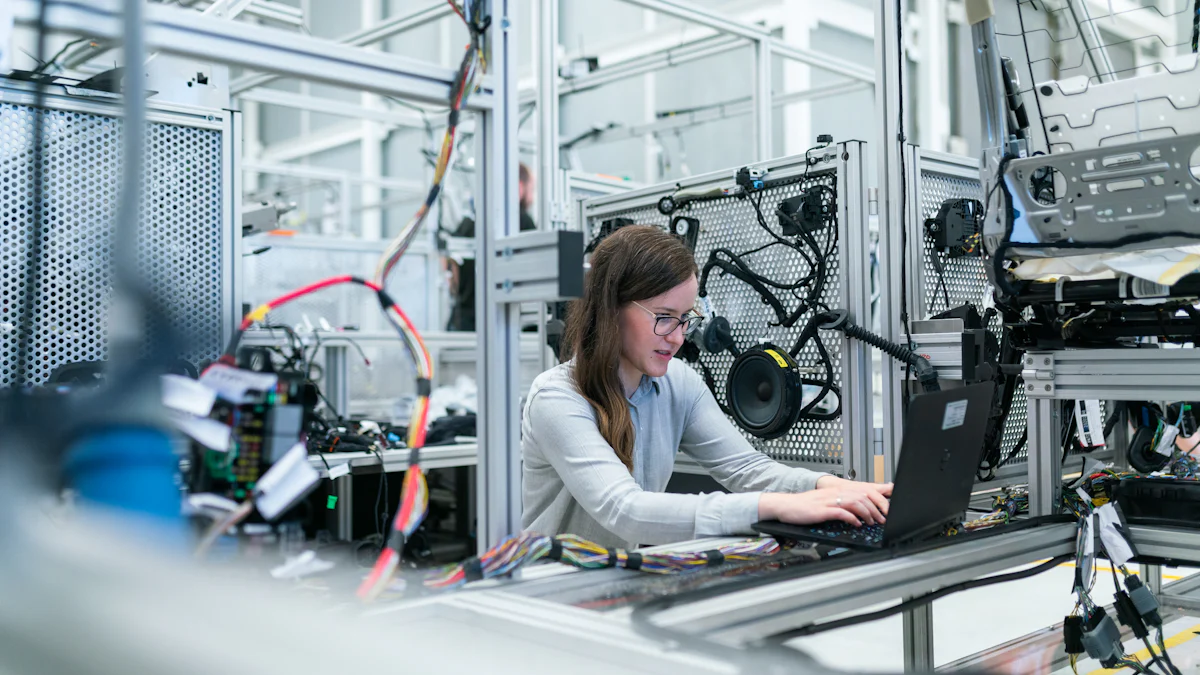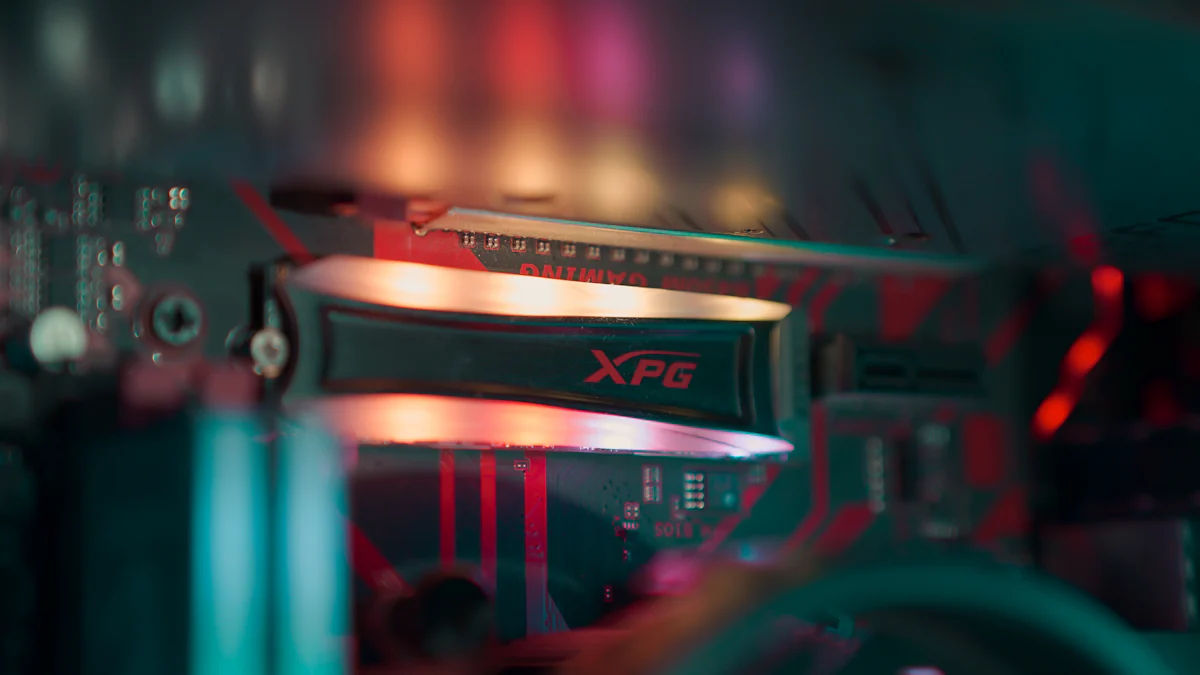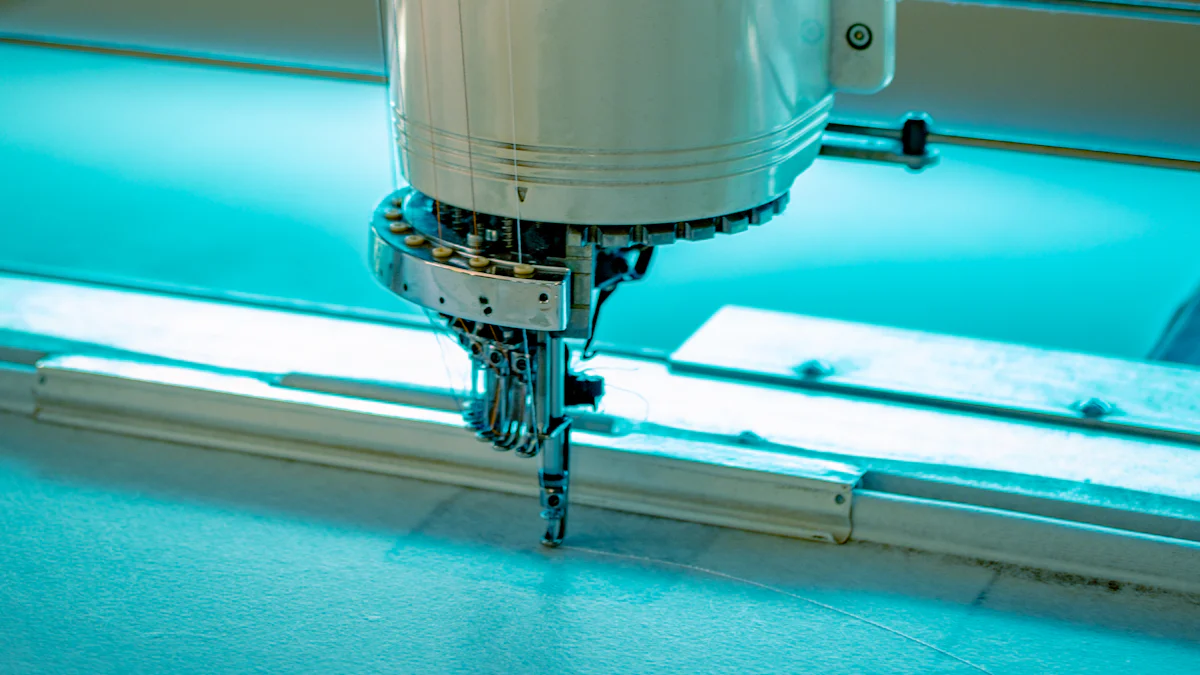
Les capteurs à canon épi sont des composants essentiels de la fabrication de semi-conducteurs. Ils fournissent un soutien essentiel aux wafers pendant le processus de dépôt épitaxique, assurant stabilité et précision. Ces capteurs, souvent fabriqués à partir de matériaux de haute pureté comme le carbure de silicium ou le graphite, résistent aux températures extrêmes et résistent à la corrosion chimique. Leur conception favorise une distribution uniforme de la température, essentielle pour produire des wafers de haute qualité. En prévenant la contamination et en maintenant un profil thermique uniforme, les suscepteurs à canon épi jouent un rôle central dans l'efficacité et la consistance de la production de wafers. Leur fiabilité les rend indispensables dans la fabrication moderne de semi-conducteurs.
Principaux enseignements
- Les capteurs à canon épi sont essentiels au maintien de la stabilité et de la température uniforme pendant le processus de dépôt épitaxique, assurant ainsi une production de wafer de haute qualité.
- Fabriqués à partir de matériaux à haute pureté comme le carbure de silicium, ces capteurs résistent aux températures extrêmes et à la corrosion chimique, améliorant ainsi leur durabilité et leur performance.
- Leur conception cylindrique permet le traitement simultané de plusieurs wafers, optimisant l'efficacité de fabrication sans compromettre la qualité.
- En prévenant la contamination et en assurant un profil thermique uniforme, les capteurs à canon épi améliorent considérablement le rendement et la fiabilité des dispositifs semi-conducteurs.
- Investir dans une technologie de sucepteur avancée peut réduire les coûts d'entretien et améliorer l'efficacité globale de la fabrication de semi-conducteurs.
- La performance constante des capteurs à canon épi est essentielle pour obtenir des films minces exempts de défauts, ce qui affecte directement la fonctionnalité des produits semi-conducteurs finaux.
Qu'est-ce que les récepteurs Epi Barrel?

Définition et objet des récepteurs Epi Barrel
Les récepteurs à canon épi servent de composants essentiels dans la fabrication de semi-conducteurs. Ces plates-formes cylindriques supportent les wafers pendant le dépôt épitaxique, un processus essentiel pour créer des dispositifs semi-conducteurs de haute qualité. En tenant et en réchauffant simultanément plusieurs wafers, ils assurent une répartition uniforme de la température entre les substrats. Cette uniformité est essentielle pour obtenir des dépôts constants de film mince, ce qui a une incidence directe sur la performance et la fiabilité des produits semi-conducteurs finaux. Leur conception minimise également la contamination, assurant un environnement propre pour le traitement des wafers.
L'objectif premier d'un suscepteur à canon épi est d'améliorer l'efficacité et la précision de la production de wafers. Les fabricants comptent sur ces composants pour maintenir la stabilité pendant les processus à haute température. Sans eux, il serait presque impossible d'atteindre le niveau de précision requis dans la croissance épitaxiale. Leur rôle va au-delà du simple soutien; ils contribuent activement à la qualité et au rendement globaux de la fabrication de semi-conducteurs.
Structure et matériaux des récepteurs Epi Barrel
Les suscepteurs à canon épi sont généralement fabriqués à partir de matériaux à haute pureté comme le carbure de silicium (SiC) ou le graphite. Ces matériaux sont choisis pour leur capacité à résister aux températures extrêmes et à la corrosion chimique. Le graphite revêtu de SiC, en particulier, est très apprécié pour sa performance thermique supérieure et sa durabilité. Ce revêtement améliore la résistance du suscepteur à l'oxydation et assure une durée de vie opérationnelle plus longue.
La structure cylindrique du suscepteur lui permet de tenir simultanément plusieurs wafers, optimisant le débit dans les procédés de fabrication. Sa conception favorise un profil thermique uniforme, qui est crucial pour un dépôt épitaxique uniforme. De plus, le débit de gaz laminaire autour du suscepteur réduit le risque d'impuretés et de contamination. Cette combinaison de matériaux avancés et de conception réfléchie rend les suscepteurs épi barils indispensables dans la fabrication moderne de semi-conducteurs.
Rôle des récepteurs Epi Barrel dans les dépôts épitaxiaux
Dans le processus de dépôt épitaxial, les récepteurs du baril épi jouent un rôle central. Ils fournissent une plate-forme stable pour les wafers, assurant un alignement précis et un chauffage cohérent. Cette stabilité est essentielle pour obtenir la croissance souhaitée de films minces sur la surface de la galette. La capacité du suscepteur à maintenir un profil thermique uniforme garantit que le processus de dépôt se produit uniformément dans toutes les plaquettes.
De plus, les matériaux à haute pureté utilisés dans ces capteurs empêchent la contamination pendant le processus de dépôt. Les contaminants peuvent compromettre la qualité des films minces, entraînant des défauts dans les dispositifs semi-conducteurs finaux. En minimisant de tels risques, les capteurs d'épi barils contribuent à des rendements plus élevés et à une meilleure fiabilité du produit. Leur rôle dans les dépôts épitaxiaux souligne leur importance dans l'industrie des semi-conducteurs.
Comment fonctionnent les récepteurs Epi Barrel?
Fonctionnalité des processus de dépôt épitaxiaux
J'ai observé que la fonctionnalité d'un suscepteur à canon épi est au cœur de sa conception. Ces composants fonctionnent dans des réacteurs épitaxiaux, où les températures varient souvent entre 1000°C et 1200°C. Le rôle principal du suscepteur est de fournir une plate-forme stable et uniforme pour les wafers pendant le processus de dépôt épitaxique. Cette stabilité garantit que les films minces se développent régulièrement sur toute la surface du wafer, ce qui est essentiel pour produire des dispositifs semi-conducteurs de haute qualité.
La structure cylindrique du suscepteur lui permet de tenir plusieurs wafers simultanément. Cette conception optimise le débit tout en maintenant un profil thermique uniforme. Les matériaux à haute pureté, comme le carbure de silicium (SiC) ou le graphite revêtu de SiC, améliorent la conductivité thermique et résistent à l'oxydation. Ces propriétés garantissent que le suscepteur fonctionne de manière fiable dans des conditions extrêmes. En prévenant les impuretés et la contamination, le suscepteur protège l'intégrité des wafers, ce qui affecte directement le rendement et la qualité des produits finaux.
"Notre Scepteur Barrel Epi System offre d'excellentes performances thermiques, même des profils thermiques et une adhérence supérieure au revêtement », comme l'ont souligné des experts de l'industrie. Cette ingénierie avancée permet de répondre aux exigences rigoureuses de la fabrication moderne de semi-conducteurs.
Assurer la stabilité et l'efficacité du traitement des déchets
La stabilité et l'efficacité définissent le succès opérationnel d'un capteur de baril épi. J'ai constaté que ces composants excellent dans le maintien d'un alignement précis et d'un chauffage cohérent pendant le traitement des plaquettes. La structure robuste du suscepteur minimise les vibrations et les perturbations mécaniques, qui pourraient autrement compromettre le processus de dépôt. Cette stabilité est essentielle pour atteindre les caractéristiques de film mince souhaitées.
L'efficacité découle de la capacité du suscepteur à gérer les températures élevées et à résister à la corrosion chimique. Le revêtement SiC, appliqué par un procédé de dépôt de vapeur chimique (CVD), améliore la durabilité et la performance thermique du suscepteur. Ce revêtement réduit également les exigences d'entretien, ce qui en fait une solution rentable pour les serpillères semi-conducteurs. De plus, le débit de gaz laminaire autour du suscepteur minimise le risque de contamination, ce qui améliore encore l'efficacité du traitement des plaquettes.
La combinaison de matériaux avancés, d'ingénierie précise et de conception innovante fait de l'épi barillet un outil indispensable dans la fabrication de semi-conducteurs. Sa capacité à produire des résultats uniformes dans des conditions exigeantes souligne sa valeur dans l'industrie.
Utilisations des récepteurs Epi Barrel dans la fabrication de semi-conducteurs

Applications dans la production de Wafer de haute qualité
J'ai observé que les récepteurs du baril épi jouent un rôle vital dans la production de wafers de haute qualité. Ces composants assurent l'uniformité pendant le processus de dépôt épitaxial, qui est essentiel pour créer des plaquettes semi-conducteurs exemptes de défauts. En maintenant un profil thermique uniforme, ils aident à obtenir une croissance constante des films minces dans toutes les plaquettes. Cette cohérence influe directement sur les performances et la fiabilité des dispositifs semi-conducteurs.
Les fabricants s'appuient sur des suscepteurs épi barils pour prévenir la contamination pendant le traitement des plaquettes. Les matériaux à haute pureté, comme le carbure de silicium (SiC) ou le graphite revêtu de SiC, résistent à l'oxydation et à la corrosion chimique. Cette résistance assure un environnement propre pour la production de wafers, réduisant ainsi le risque d'impuretés. J'ai constaté que cette fonctionnalité améliore considérablement la qualité du produit final.
"Le système Epi Sceptor Barrel offre d'excellentes performances thermiques et prévient la contamination et les impuretés", a noté des experts de l'industrie. Cette capacité en fait un outil indispensable à la production de wafers de haute qualité.
La possibilité de traiter plusieurs wafers simultanément optimise davantage l'efficacité de fabrication. La conception cylindrique du capteur permet un débit maximal sans compromettre la qualité. Cette combinaison de précision et de productivité met en évidence l'importance des suscepteurs épi barils dans la fabrication des semi-conducteurs.
Améliorer la précision et le rendement dans la fabrication
La précision et le rendement définissent le succès de la fabrication de semi-conducteurs, et les récepteurs à canon épi excellent dans les deux domaines. Ces composants assurent un alignement précis et un chauffage stable pendant le processus de dépôt épitaxique. La stabilité minimise les perturbations mécaniques, qui pourraient autrement entraîner des défauts dans les films minces. J'ai vu comment cette précision contribue directement à des rendements plus élevés et à une meilleure performance de l'appareil.
Les matériaux avancés utilisés dans les suscepteurs épi barils améliorent leur durabilité et conductivité thermique. Les revêtements SiC, appliqués par dépôt de vapeur chimique (CVD), améliorent la résistance à l'usure et à l'oxydation. Cette durabilité réduit les exigences de maintenance, ce qui en fait une solution rentable pour les fabricants. En maintenant une performance constante dans des conditions extrêmes, ces composants assurent un traitement fiable des wafers.
De plus, la conception du débit de gaz laminaire autour du suscepteur minimise les risques de contamination. Cette fonction non seulement protège les wafers mais améliore également l'efficacité globale du processus de fabrication. Je pense que cette combinaison d'ingénierie de précision et de conception innovante rend les suscepteurs épi barils essentiels pour améliorer le rendement et maintenir des normes élevées dans la production de semi-conducteurs.
Pourquoi les récepteurs Epi Barrel Matière
Importance d'une qualité uniforme de la cire
J'ai vu à quel point la qualité des plaquettes définit le succès de la fabrication de semi-conducteurs. Les récepteurs à canon épi assurent cette cohérence en maintenant une distribution uniforme de la température pendant le dépôt épitaxique. Cette uniformité empêche les défauts dans les films minces, ce qui affecte directement les performances des dispositifs semi-conducteurs. Sans ces composants, il serait presque impossible d'atteindre la précision requise pour les wafers de haute qualité.
Les matériaux utilisés dans les suscepteurs épi barils, comme le carbure de silicium (SiC) ou le graphite revêtu de SiC, résistent à l'oxydation et à la corrosion chimique. Cette résistance assure un environnement de traitement propre, réduisant les risques de contamination. Les Suscepteur de barils Système épi en témoigne son adhérence supérieure au revêtement et sa capacité à prévenir les impuretés. Ces caractéristiques en font un choix fiable pour les fabricants visant à produire des plaquettes sans défauts.
J'ai observé que la conception cylindrique du suscepteur joue également un rôle critique. Il permet d'obtenir des profils thermiques sur plusieurs wafers, optimisant le débit sans compromettre la qualité. Cette combinaison de matériaux avancés et d'ingénierie réfléchie garantit que les capteurs à canon épi produisent toujours des résultats de haute qualité.
"Notre Scepteur Barrel Epi System offre d'excellentes performances thermiques et prévient la contamination et les impuretés », comme l'ont souligné des experts de l'industrie. Cette capacité souligne l'importance de ces composantes pour le maintien de la qualité des wafers.
Impact sur le semi-conducteur Performance et fiabilité de l'appareil
La performance et la fiabilité des dispositifs semi-conducteurs dépendent fortement de la qualité des plaquettes utilisées. Les suscepteurs à canon épi contribuent à ce résultat en assurant un alignement précis et un chauffage stable pendant le traitement des plaquettes. J'ai constaté que cette stabilité minimise les perturbations mécaniques, qui pourraient autrement conduire à des défauts dans les films minces. Ces défauts compromettent souvent la fonctionnalité des dispositifs finaux.
Le DCV Suscepteur à barres enduit de SiC par VeTek Semiconductor démontre comment les matériaux avancés améliorent la qualité et le rendement du produit. Sa conductivité thermique excellente et sa résistance à haute température le rendent idéal pour les environnements difficiles pendant la croissance épitaxiale. Ces propriétés garantissent que les wafers restent exempts de contamination, améliorant directement la fiabilité de l'appareil.
Les fabricants s'appuient sur des capteurs à canon épi pour répondre aux exigences rigoureuses de la fabrication moderne de semi-conducteurs. Leur capacité à maintenir une performance constante dans des conditions extrêmes garantit que les appareils finaux fonctionnent comme prévu. Je pense que cela les rend indispensables pour atteindre à la fois une production de haute qualité et la fiabilité des appareils à long terme.
Les suscepteurs à canon épi sont des composants indispensables dans la fabrication de semi-conducteurs. Ils assurent un support précis des wafers et une répartition uniforme de la température pendant les dépôts épitaxiaux, ce qui est essentiel pour produire des wafers de haute qualité. Leurs matériaux de pointe, comme le graphite recouvert de SiC, résistent à l'oxydation et à la contamination, améliorant à la fois l'efficacité et la fiabilité.
« Les suscepteurs de barils jouent un rôle clé dans les processus à haute température comme la fabrication de semi-conducteurs », soulignent les experts de l'industrie.
En optimisant le débit et en maintenant des résultats cohérents, ces capteurs contribuent directement à la performance et à la fiabilité des dispositifs semi-conducteurs modernes. Leur rôle dans l'obtention de la précision et de l'efficacité souligne leur valeur dans le progrès de la technologie des semi-conducteurs.